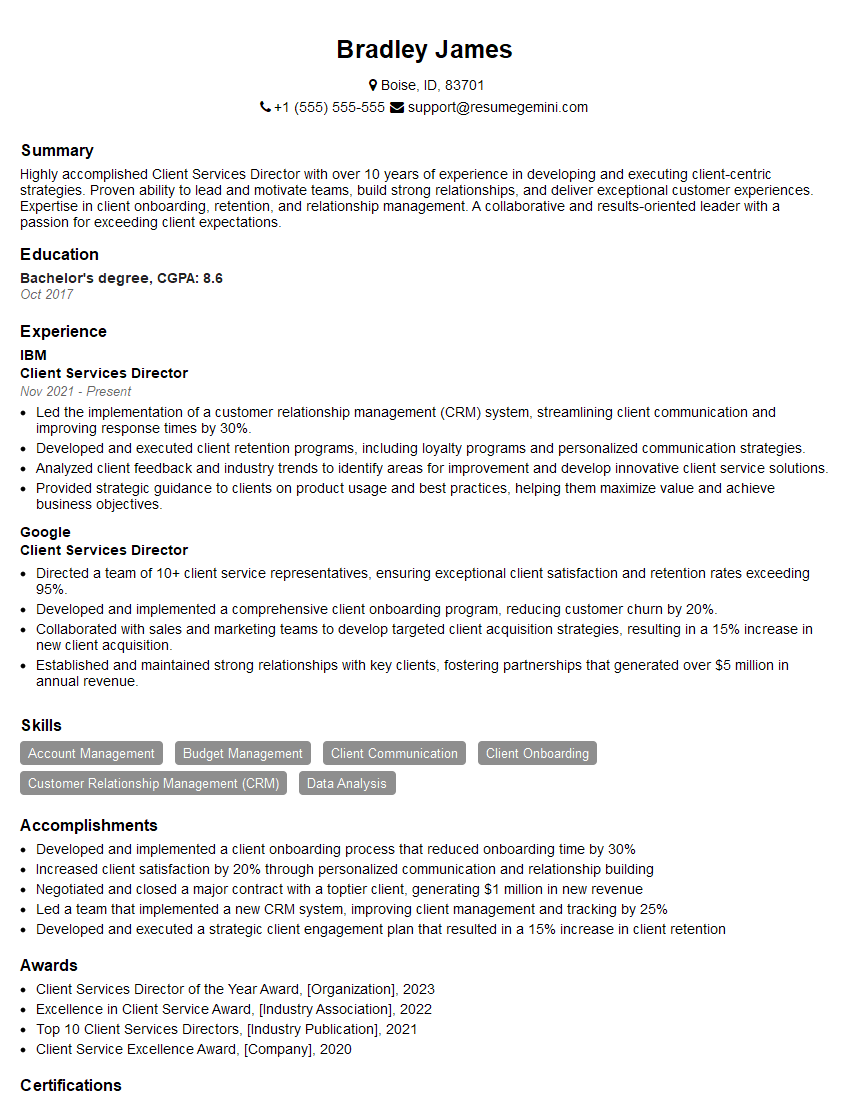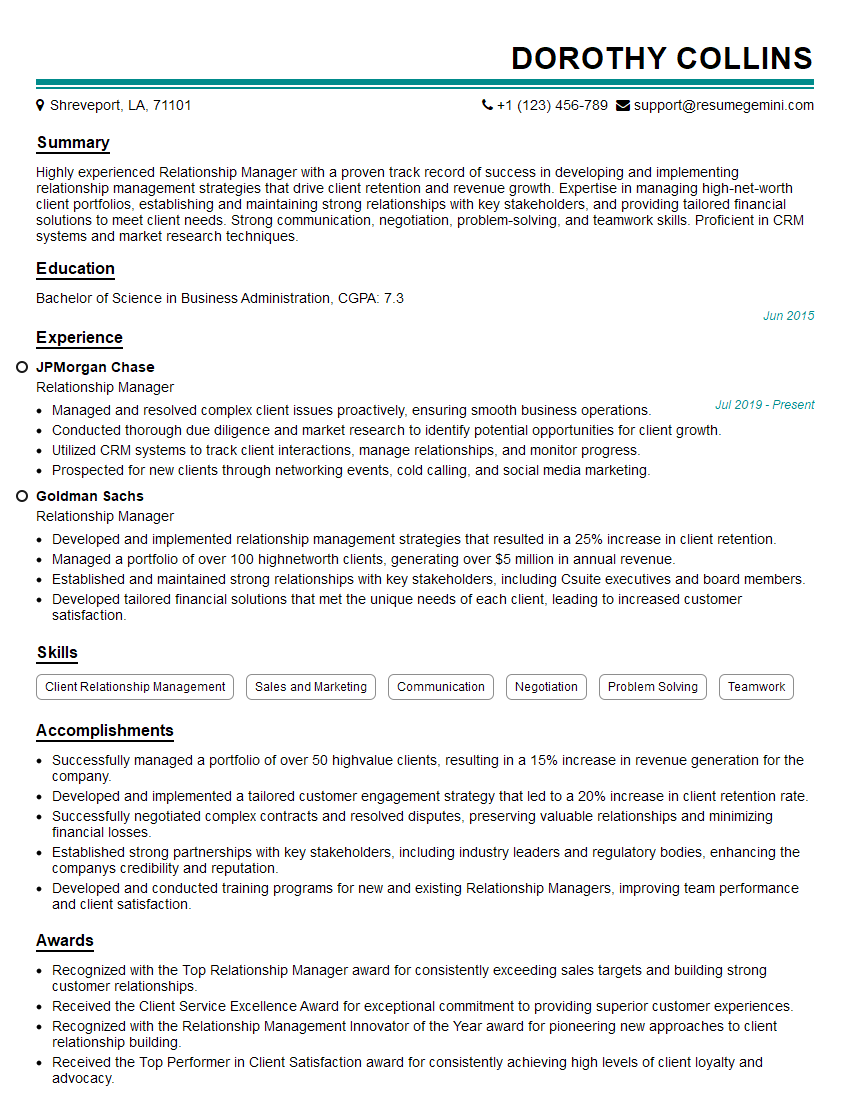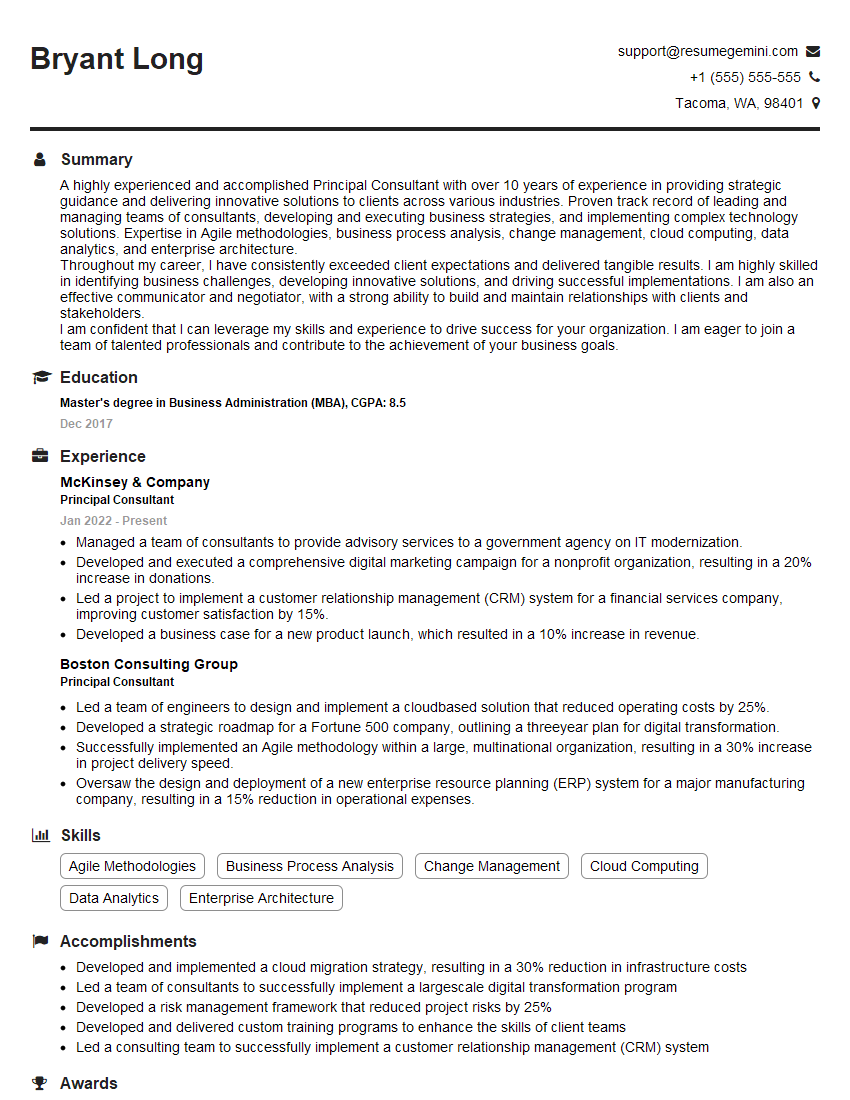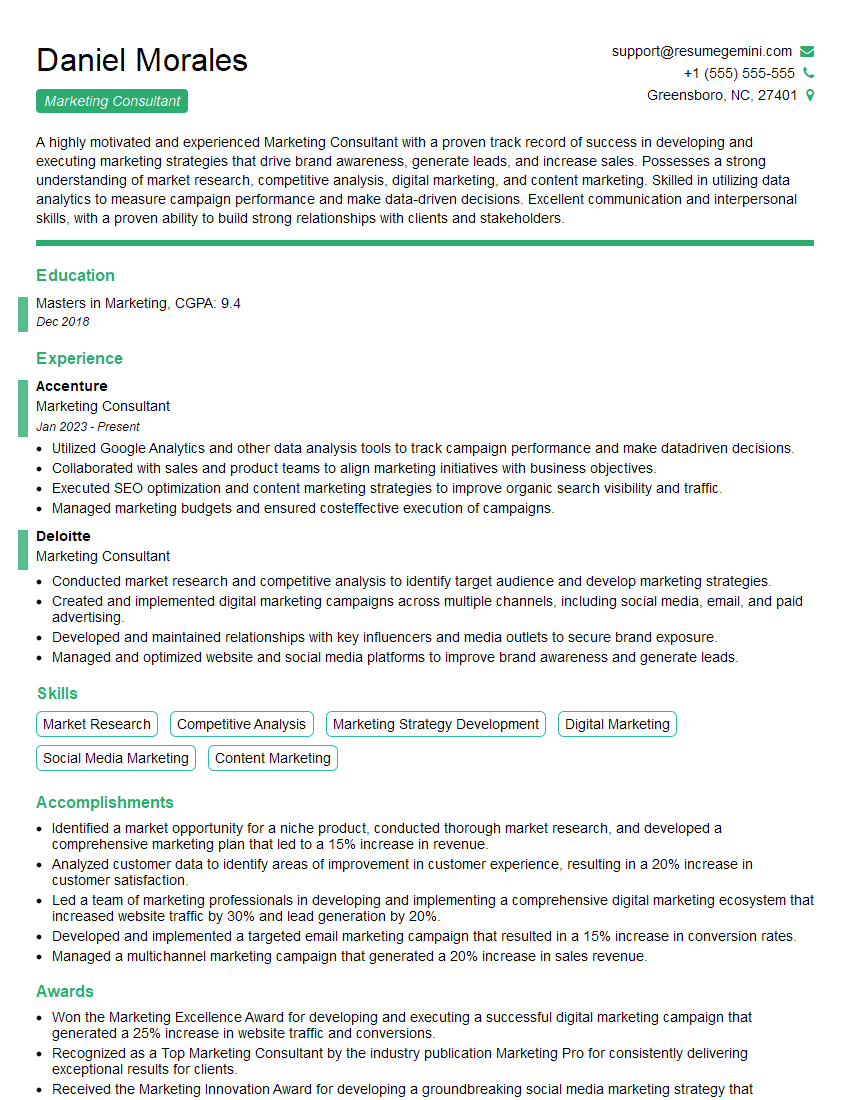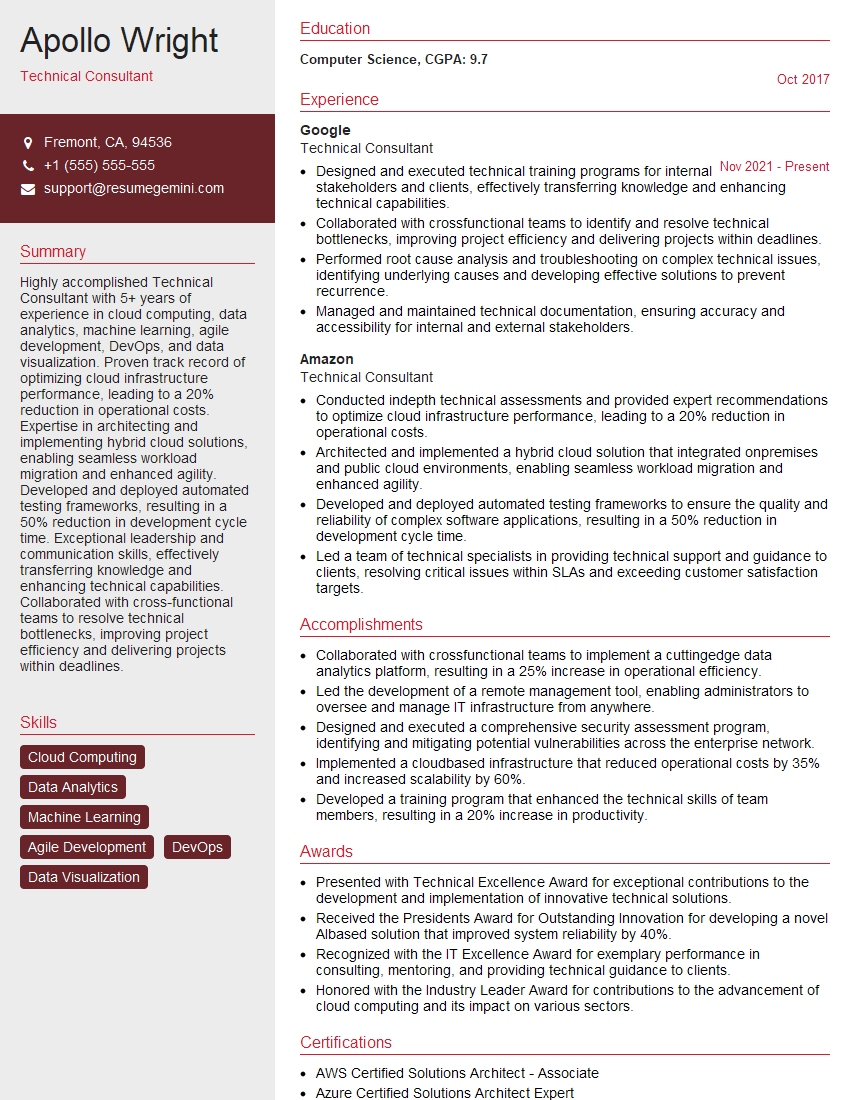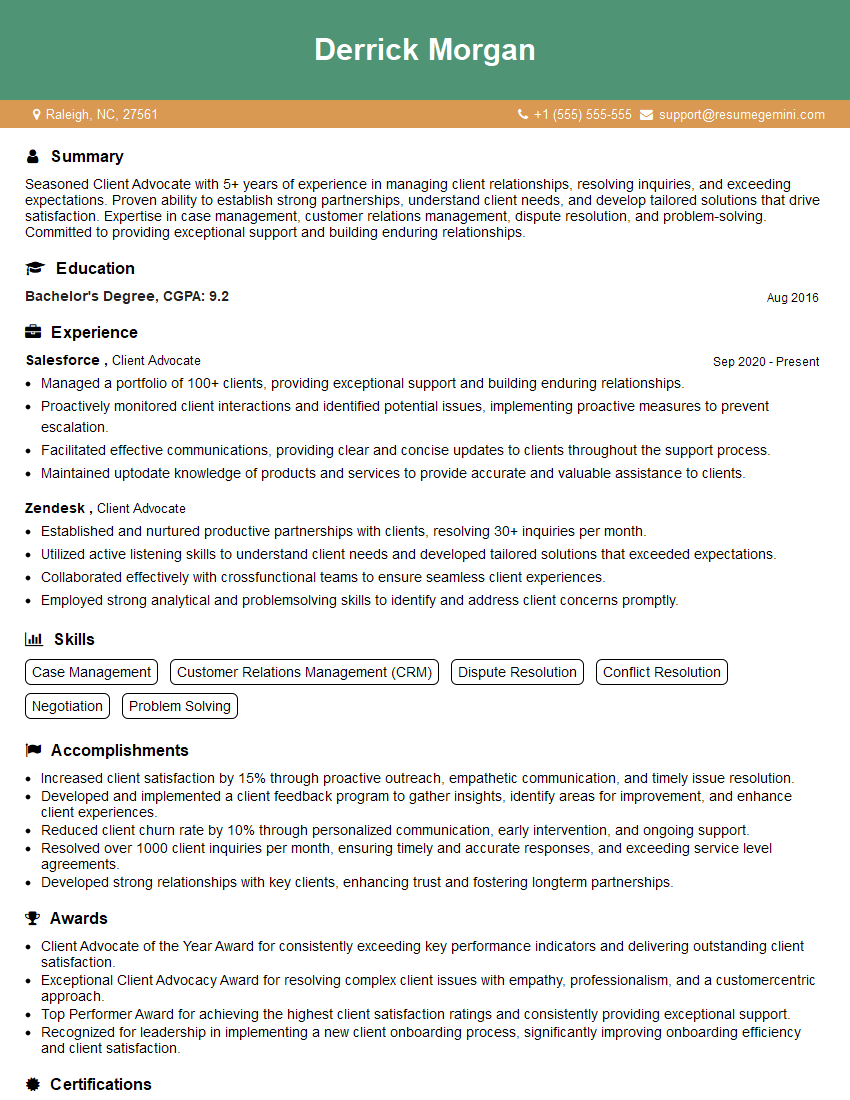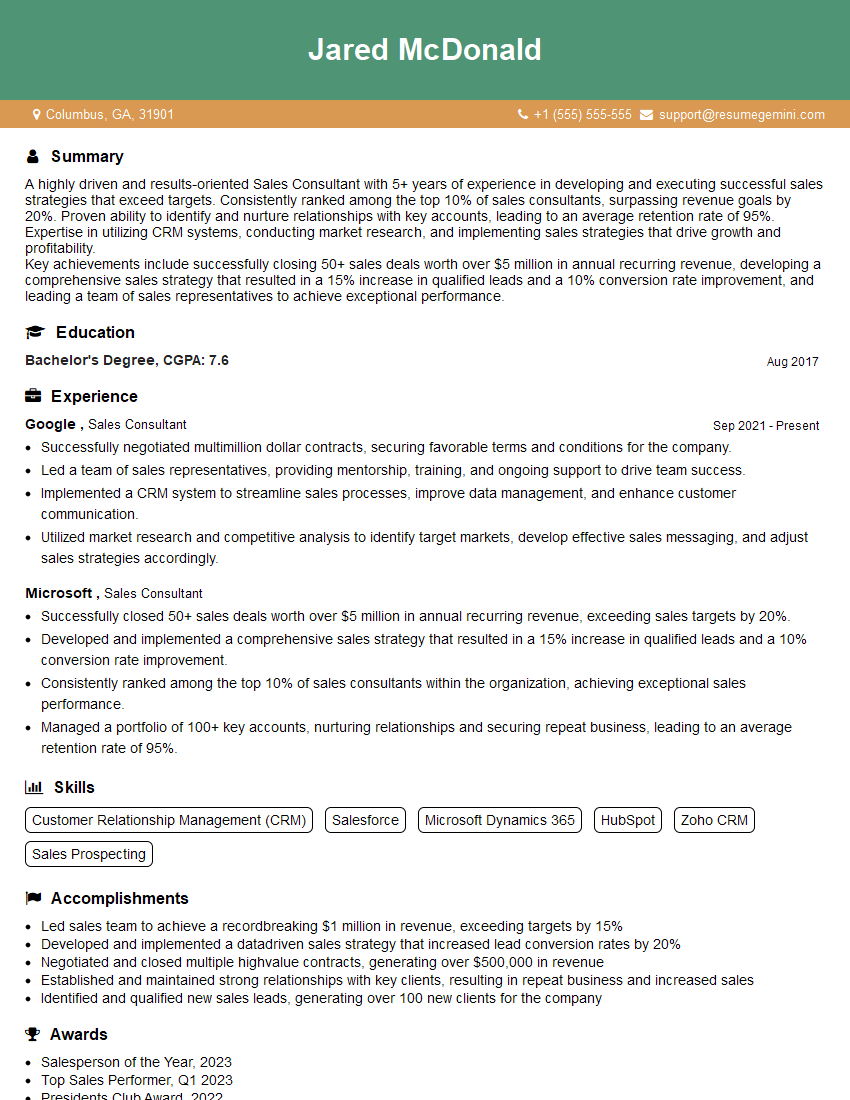Interviews are opportunities to demonstrate your expertise, and this guide is here to help you shine. Explore the essential Client Communication and Consultation interview questions that employers frequently ask, paired with strategies for crafting responses that set you apart from the competition.
Questions Asked in Client Communication and Consultation Interview
Q 1. Describe your approach to managing client expectations.
Managing client expectations is crucial for a successful client-consultant relationship. My approach is built on a foundation of proactive communication, realistic goal-setting, and consistent updates. I begin by clearly defining the scope of work and deliverables during the initial consultation. This involves not just outlining what I’ll do, but also clearly stating limitations and potential challenges. I use a collaborative approach, involving the client in the process of defining realistic timelines and success metrics. This ensures everyone is on the same page from the start.
For instance, if a client wants a website redesigned in a week, I’ll explain the complexities involved and propose a more realistic timeframe, perhaps breaking the project down into manageable phases with corresponding deadlines. I then provide regular progress reports, highlighting achievements and proactively addressing any potential delays. This consistent communication prevents misunderstandings and keeps expectations well-aligned with the project’s reality.
Q 2. How do you handle difficult or demanding clients?
Handling difficult or demanding clients requires patience, empathy, and strong communication skills. My strategy focuses on understanding the root cause of their dissatisfaction. I actively listen to their concerns, validating their feelings even if I don’t necessarily agree with their perspective. I approach the situation with a calm and professional demeanor, avoiding defensiveness. The key is to transform a confrontational situation into a collaborative problem-solving session.
For example, if a client is upset about a delay, instead of getting defensive, I’ll acknowledge their frustration and explain the reasons for the delay transparently. I’ll then collaboratively discuss solutions, perhaps prioritizing certain tasks or adjusting the timeline to meet their needs where possible. In some cases, it may be necessary to set clear boundaries – politely but firmly – to manage unreasonable demands. Ultimately, the goal is to find a mutually agreeable solution that maintains a professional relationship.
Q 3. Explain your process for building rapport with new clients.
Building rapport with new clients is about establishing trust and understanding. My process begins with a thorough intake – a structured conversation designed to understand their business, their goals, and their challenges. I ask open-ended questions, actively listening and showing genuine interest in their perspective. This initial conversation is not just about gathering information, but about building a connection based on mutual respect and understanding.
After the initial meeting, I follow up with a personalized summary of our conversation, confirming my understanding of their needs and outlining the next steps. I also make myself readily available for questions and maintain consistent communication throughout the project. This personalized touch shows that I value their business and am committed to their success. I might also research their company beforehand to show I’ve taken the time to learn about their work.
Q 4. How do you identify and address client needs?
Identifying and addressing client needs is a continuous process. It starts with active listening during the initial consultation and continues throughout the project lifecycle. I use a combination of techniques to uncover their needs, including open-ended questions, observation, and analysis of their existing materials. I also look for clues in their body language and tone of voice. This holistic approach ensures I capture both their explicit and implicit needs.
For instance, a client might explicitly state they need a website with an e-commerce function. However, by observing their existing marketing materials and listening to their broader business goals, I might identify an implicit need for improved SEO or social media integration to drive more sales. Addressing both explicit and implicit needs leads to more comprehensive and effective solutions.
Q 5. What communication methods do you prefer for different client situations?
My communication method adapts to the client and the situation. For urgent matters or quick updates, I prefer email or a quick phone call. For complex discussions or strategic planning, I favor video conferencing to allow for richer communication and better collaboration. I’m always mindful of the client’s preferred communication style. Some clients may prefer detailed email updates, while others prefer short, concise messages. Building a relationship of trust and understanding guides the method of communication.
For instance, for a large, multinational corporation, I might lean towards formal email correspondence and scheduled video conferences. However, for a small, local business, a quick phone call or a less formal email might be more appropriate.
Q 6. How do you prioritize multiple client requests?
Prioritizing multiple client requests requires a well-organized approach. I use a project management system to track all tasks and deadlines, assigning priorities based on urgency, impact, and client agreements. This system allows me to allocate my time and resources effectively, ensuring all clients receive the attention they need. Clear communication is vital here, keeping clients informed about the order of tasks and the estimated completion times for their requests.
For example, I might prioritize a critical bug fix for one client over a less urgent feature request from another. I’ll clearly communicate this to both clients, setting realistic expectations and maintaining transparency throughout the process. Using a Kanban board or similar visual tools can help both me and the client visualize the workflow and understand the prioritization.
Q 7. How do you handle conflicts or disagreements with clients?
Handling conflicts or disagreements with clients requires a diplomatic and solution-oriented approach. I prioritize active listening and understanding the client’s perspective, even if I don’t agree with it. I aim to find common ground by focusing on shared goals and objectives. It’s important to separate the issue from the person – addressing the problem without making it personal.
For example, if a client disagrees with my suggested approach, I’ll explain the rationale behind my recommendation, but also be open to exploring alternative solutions. I might present different options, emphasizing their pros and cons, and working collaboratively to reach a solution that satisfies both parties. If necessary, I may involve a neutral third party to mediate if the conflict escalates beyond my ability to resolve it.
Q 8. Describe your experience with client feedback and how you utilize it.
Client feedback is the lifeblood of improving client communication and service delivery. I actively solicit feedback through various channels, including post-project surveys, informal check-ins, and formal feedback sessions. I don’t just passively collect data; I analyze it meticulously to identify trends and areas for improvement. For example, if several clients mention difficulty understanding a certain technical aspect, I’ll revise my explanation strategy, perhaps incorporating visual aids or simpler terminology. I then use this refined approach in future consultations. This iterative process allows me to consistently refine my communication, ensuring clarity and client satisfaction.
I categorize feedback using a simple system: Positive feedback highlights what’s working well, constructive criticism pinpoints areas needing adjustment, and negative feedback identifies critical issues requiring immediate attention. This approach allows for a systematic approach to improvement.
Q 9. How do you measure the success of your client interactions?
Measuring the success of client interactions goes beyond simply completing a project. I use a multi-faceted approach:
- Client Satisfaction Surveys: Post-project surveys are crucial for gauging overall satisfaction with the process and outcome.
- Project Completion Rate & Timeliness: Meeting deadlines and delivering projects within budget demonstrates efficiency and reliability.
- Client Retention: Repeat business and referrals are the ultimate indicators of successful long-term relationships.
- Qualitative Feedback: Analyzing comments and suggestions reveals deeper insights into client perceptions and areas for growth. For example, a client complimenting the clarity of my explanations indicates a strength in communication.
- Net Promoter Score (NPS): This metric assesses the likelihood of a client recommending my services, providing a quantifiable measure of client loyalty.
By combining quantitative data (like completion rates) and qualitative feedback (like client comments), I obtain a comprehensive understanding of my performance and areas for future enhancement.
Q 10. How do you tailor your communication style to different client personalities?
Adapting communication styles is crucial for effective client interaction. I tailor my approach based on observed personality traits and communication preferences. For example:
- Direct Communicators: I use a concise, fact-based approach, focusing on efficiency and clear action items.
- Relationship-Oriented Communicators: I prioritize building rapport by engaging in small talk and focusing on mutual understanding before delving into specifics.
- Detail-Oriented Communicators: I provide comprehensive information, addressing all potential questions and concerns thoroughly.
- Visual Learners: I incorporate visual aids such as charts, graphs, and presentations to aid understanding.
I observe client behavior during initial interactions – their body language, the way they ask questions, and their overall tone – to get a sense of their preferred communication style. I then adjust accordingly. It’s a process of active listening and thoughtful adaptation.
Q 11. Describe a time you had to deliver difficult news to a client.
I once had to inform a long-standing client that due to unforeseen circumstances, we had to postpone a major project launch. This was disappointing news, especially given the significant effort already invested by both parties. My approach involved:
- Empathy and Understanding: I acknowledged their disappointment and frustration, validating their feelings before explaining the situation.
- Transparency and Honesty: I clearly and concisely explained the reasons for the delay, providing specific details without making excuses.
- Proactive Solutions: I presented a revised timeline and mitigation plan to minimize disruption and keep them informed every step of the way. This included regular updates and open communication channels.
- Commitment to Recovery: I reinforced our commitment to delivering a successful project, emphasizing our dedication to rectifying the situation.
While the news was unwelcome, my focus on open communication and problem-solving helped maintain the client relationship. The client understood the situation and appreciated our proactive approach to resolution.
Q 12. How do you use technology to enhance client communication?
Technology plays a pivotal role in enhancing client communication. I utilize various tools to streamline interactions and improve efficiency:
- Project Management Software (e.g., Asana, Trello): For task tracking, collaboration, and transparent progress updates.
- Video Conferencing (e.g., Zoom, Google Meet): For efficient and engaging remote meetings, fostering a personal connection even when geographically distant.
- Secure File Sharing Platforms (e.g., Dropbox, Google Drive): For secure and efficient document sharing, avoiding email overload and ensuring everyone has access to the latest versions.
- CRM Software (e.g., Salesforce, HubSpot): To maintain a centralized repository of client information, ensuring consistent and personalized communication.
- Communication Platforms (e.g., Slack, Microsoft Teams): For quick and informal updates and easy access for clients.
By leveraging these technologies, I ensure seamless communication, enhanced collaboration, and increased efficiency in project management, resulting in improved client experiences.
Q 13. What is your experience with client presentations?
I have extensive experience delivering client presentations, ranging from informal progress updates to formal proposals. My approach is to:
- Clearly Define Objectives: Understanding the presentation’s purpose (e.g., securing a contract, updating stakeholders) guides content and delivery.
- Tailor Content: The presentation’s complexity and style should match the audience’s technical expertise and familiarity with the subject matter.
- Visually Engaging Design: I utilize clear visuals, concise bullet points, and a consistent design to maintain audience engagement.
- Practice and Rehearse: Thorough rehearsal ensures smooth delivery, increasing confidence and minimizing potential disruptions.
- Gather Feedback: I solicit feedback after each presentation to identify areas for improvement in future presentations.
A well-structured presentation with strong visual aids and clear communication significantly enhances understanding and builds trust with clients.
Q 14. How do you stay organized and manage your client workload?
Managing a client workload effectively involves careful organization and prioritization. I employ several strategies:
- Project Prioritization Matrix: I use a matrix (e.g., Eisenhower Matrix) to prioritize tasks based on urgency and importance, ensuring that critical tasks receive timely attention.
- Detailed Scheduling: I utilize a calendar to schedule meetings, deadlines, and dedicated work blocks for specific projects. This allows for effective time management and prevents scheduling conflicts.
- Client Relationship Management (CRM) Software: Using a CRM to centralize client information, track communication, and manage project timelines ensures efficient organization.
- Regular Review & Adjustment: I conduct regular reviews of my schedule and workload to ensure tasks stay aligned with priorities and deadlines. I adapt as needed, proactively addressing potential issues.
- Delegation (where applicable): Effective delegation of tasks when possible helps manage workload efficiently and frees up time for high-priority items.
This combination of tools and methods ensures I maintain a structured workflow, preventing overwhelm and allowing for proactive management of client needs and projects.
Q 15. Describe your experience with client contract negotiations.
Client contract negotiations require a delicate balance between securing favorable terms for my organization and building a strong, collaborative relationship with the client. My approach involves thorough preparation, active listening, and a win-win mentality. Before entering negotiations, I meticulously review the contract, identifying potential areas of conflict or ambiguity. I then research the client’s industry and past contracts to understand their typical negotiation strategies. During the negotiation process, I focus on clear and concise communication, ensuring that both sides understand the terms and implications of each clause. I’m adept at identifying creative solutions that address both parties’ needs, often leveraging my understanding of the project’s scope and the client’s business goals. For instance, in a recent project with a software development company, we initially disagreed on the payment schedule. By proposing a phased delivery model tied to specific milestones, we were able to structure a payment plan that mitigated both the client’s financial risk and our company’s cash flow concerns, leading to a mutually satisfactory agreement.
Career Expert Tips:
- Ace those interviews! Prepare effectively by reviewing the Top 50 Most Common Interview Questions on ResumeGemini.
- Navigate your job search with confidence! Explore a wide range of Career Tips on ResumeGemini. Learn about common challenges and recommendations to overcome them.
- Craft the perfect resume! Master the Art of Resume Writing with ResumeGemini’s guide. Showcase your unique qualifications and achievements effectively.
- Don’t miss out on holiday savings! Build your dream resume with ResumeGemini’s ATS optimized templates.
Q 16. How do you proactively identify and mitigate potential client problems?
Proactive problem identification is crucial for maintaining client satisfaction. My strategy involves a multi-pronged approach. Firstly, I establish open communication channels, encouraging clients to voice concerns or challenges early on. Regular check-in calls, progress reports, and project-specific communication platforms facilitate this. Secondly, I conduct thorough risk assessments at the project initiation stage, identifying potential roadblocks like resource constraints, technological limitations, or regulatory hurdles. This allows for proactive mitigation planning, including contingency measures and alternative solutions. For instance, if a project requires specialized software, I’ll investigate alternative options in case the preferred software faces unexpected delays or compatibility issues. Finally, I closely monitor project metrics, looking for deviations from the plan. Any indication of slippage or unmet expectations triggers immediate investigation and corrective action. Think of it like navigating a ship – constant monitoring and adjustments ensure we reach our destination smoothly.
Q 17. How do you manage client relationships across multiple time zones?
Managing client relationships across multiple time zones demands meticulous planning and excellent communication. I leverage technology to bridge geographical barriers. Tools like project management software with integrated communication features (like Slack, Asana, or Monday.com), scheduled video conferencing, and email with clear time zone specifications are essential. I always respect the client’s time zone and schedule communication accordingly, avoiding late-night calls or emails unless absolutely necessary. To ensure clarity, I proactively outline communication expectations upfront, setting clear response times and preferred methods of contact. For instance, I might suggest a weekly check-in call at a time convenient for both parties, supplemented by daily email updates summarizing progress. This structured approach ensures consistent communication while respecting everyone’s work-life balance.
Q 18. How do you keep clients informed of project progress?
Keeping clients informed is paramount. My approach combines regular updates with proactive communication. I utilize a variety of methods tailored to the client’s preferences and the project’s complexity. This could include weekly progress reports summarizing key achievements, challenges encountered, and next steps. For larger, more complex projects, I might incorporate monthly status meetings to offer a more comprehensive overview and address any questions or concerns. For quick updates on specific tasks, I leverage project management software, enabling clients to monitor progress in real-time. When encountering unforeseen issues or delays, I immediately inform the client, explaining the situation, outlining the proposed solution, and providing a revised timeline. Transparency is key – clients appreciate honesty and proactive problem-solving, even when things don’t go exactly as planned.
Q 19. Describe a time you successfully resolved a client issue.
In a previous project, we were developing a custom e-commerce platform for a client. Near the launch date, we discovered a critical bug impacting the payment gateway integration. This was a serious issue, as it jeopardized the client’s launch date and potentially their revenue stream. Instead of panicking, I immediately assembled the development team, and we worked around the clock to identify and resolve the bug. I kept the client informed every step of the way, providing regular updates on our progress and outlining the steps we were taking to rectify the situation. We ultimately resolved the issue within 48 hours, preventing a significant disruption to the client’s business. The client was incredibly grateful for our responsiveness, transparency, and dedication to finding a solution. This experience solidified the importance of proactive communication and problem-solving in maintaining strong client relationships.
Q 20. What are your strengths in client communication?
My strengths in client communication lie in my ability to adapt my style to different clients and situations. I’m a strong active listener, ensuring I fully understand the client’s needs and concerns before responding. I excel at conveying complex information clearly and concisely, using simple language and avoiding technical jargon unless absolutely necessary. I’m also proactive in seeking feedback and making necessary adjustments. I view my communication not merely as delivering information but as building a relationship based on trust and mutual understanding. I believe in creating a communication style that feels comfortable and productive for the client, whether that’s through frequent short updates or less frequent detailed reports.
Q 21. What are your weaknesses in client communication?
While I strive for perfection, I sometimes find it challenging to balance the need for thoroughness with the client’s desire for quick responses. In the past, I’ve tended to over-communicate in an effort to be completely transparent, which occasionally resulted in information overload for the client. I am actively working on refining my communication strategy to ensure I deliver information efficiently and effectively while maintaining a high level of transparency. I’m improving my ability to prioritize information and focus on what is most critical to the client at any given time, using techniques like summarization and prioritizing critical updates. My goal is to become even more adept at delivering timely, accurate, and relevant information without overwhelming the client.
Q 22. How do you handle sensitive client information?
Handling sensitive client information requires a multi-layered approach prioritizing confidentiality, integrity, and availability. This starts with adhering to strict company policies and relevant data protection regulations like GDPR or CCPA. I always treat client data as strictly confidential and only access information on a need-to-know basis.
Practically, this means using secure systems for storing and transmitting data, such as encrypted emails and cloud storage with robust access controls. I never discuss client information in public spaces or with unauthorized individuals. Access is controlled through role-based permissions within our CRM and file systems. For example, if a client shares financial details, I would only input these into designated secured fields within the CRM, accessible only to authorized personnel. Further, regular security training keeps me updated on best practices and emerging threats.
In cases of data breaches or suspected unauthorized access, I follow pre-defined incident response protocols, immediately notifying relevant parties and cooperating fully with any investigations. Client confidentiality is paramount, and I am deeply committed to upholding the highest ethical standards in data handling.
Q 23. What is your experience with CRM software?
I have extensive experience with CRM software, primarily Salesforce and HubSpot. My proficiency extends beyond basic data entry to utilizing advanced features for client relationship management. In previous roles, I’ve used Salesforce to track client interactions, manage sales pipelines, automate marketing campaigns, and generate insightful reports.
For example, I created custom dashboards in Salesforce to monitor key performance indicators (KPIs) such as client satisfaction scores and deal closure rates. This allowed me to proactively identify potential issues and tailor communication strategies to improve client outcomes. In HubSpot, I’ve leveraged the contact management system to segment client lists for targeted marketing and customized email campaigns, ultimately enhancing client engagement. I understand how to utilize CRM data to improve efficiency, forecast business opportunities, and gain valuable insights into client behavior.
Q 24. How do you adapt your communication style to different cultures?
Adapting communication style to different cultures is crucial for effective client interaction. This goes beyond simply translating languages; it involves understanding cultural nuances in communication styles and etiquette. I approach this through active listening and observation, paying close attention to verbal and non-verbal cues. I also leverage resources such as cultural guides and online tools to gain a better understanding of cultural differences.
For example, in some cultures, direct communication is valued, while in others, indirect communication is preferred. I adjust my tone and approach accordingly, ensuring my message is clearly understood and well-received, regardless of cultural background. I also pay attention to things like the use of titles, formality in language, and appropriate channels of communication. Building rapport with clients often involves showing a genuine interest in their culture and perspectives.
In practice, this may mean using more formal language when communicating with clients from certain cultures, while adopting a more informal and friendly approach with others. The key is to be flexible, respectful, and attentive to cultural subtleties.
Q 25. How do you handle client requests outside of your scope of work?
When a client requests something outside my scope of work, my priority is transparency and setting clear expectations. I begin by politely acknowledging the request and expressing my appreciation for their trust. Then, I clearly explain the limits of my current role and responsibilities.
I offer to help in several ways: First, I attempt to find an internal resource who can assist them; I might connect them with a colleague or department better equipped to handle their request. If an internal solution isn’t available, I explore external resources or services that might meet their needs. If neither of these is possible, I explain the reasons frankly and professionally, offering alternative suggestions if appropriate. Ultimately, my goal is to provide the client with the best possible solution, even if it means referring them elsewhere.
For instance, if a client asks for a complex technical analysis that’s beyond my expertise in marketing, I would connect them with our data science team or recommend a specialized consultant.
Q 26. Describe your experience with using data to inform client decisions.
Data is fundamental to informing client decisions. I have experience using various data analysis tools and techniques to interpret data, identify trends, and draw actionable insights. I routinely analyze website traffic, social media engagement, sales data, and customer feedback to provide clients with data-driven recommendations.
For example, I once used Google Analytics data to demonstrate to a client that a specific marketing campaign was significantly underperforming compared to others. This analysis led us to revise the strategy, resulting in a considerable improvement in conversion rates. In another instance, I used A/B testing results to show a client which version of their website design led to higher engagement and more sales. I can also present complex data in a clear, easily digestible format using charts, graphs and visual aids, so clients can fully grasp the conclusions and recommendations.
Ultimately, my focus is on using data to provide clients with objective evidence to support their decisions, helping them make informed choices that drive positive business outcomes.
Q 27. How do you ensure consistency in communication across your team?
Consistency in communication is crucial for building trust and maintaining a positive client relationship. Within my team, we establish clear communication protocols, using a combination of tools and strategies to ensure uniformity. We use a shared project management tool (like Asana or Monday.com) to centralize all communication, ensuring everyone is on the same page regarding project updates, deadlines, and client interactions.
We also create detailed communication templates for frequently used interactions, like project kickoff emails or progress reports. These templates ensure consistent messaging and tone, while allowing for personalization where appropriate. Regular team meetings allow us to discuss client progress, address any inconsistencies, and brainstorm best practices. Before any communication is sent to the client, I emphasize a thorough review process within the team to ensure accuracy and consistency. Open communication among team members is vital to address any potential issues promptly and to maintain a unified front in client communication.
Q 28. What is your approach to building long-term client relationships?
Building long-term client relationships is about more than just providing a service; it’s about fostering a genuine partnership. My approach centers around proactive communication, consistent follow-up, and building trust. I prioritize understanding the client’s business goals and challenges, actively listening to their concerns, and providing tailored solutions that address their specific needs.
I regularly check in with clients, not just to discuss project updates, but also to maintain an ongoing dialogue. This helps me identify potential issues early on and allows me to proactively adapt my strategies. I also show genuine appreciation for their business by recognizing milestones and achievements. This might involve sending congratulatory messages, sharing success stories, or providing personalized updates. Beyond transactional interactions, I aim to develop genuine connections with my clients, fostering mutual trust and respect that forms the foundation for long-term collaborations.
For example, I often celebrate client successes with them, whether it’s a successful product launch or a significant increase in sales. This approach shows that I’m not just interested in the work, but also in their overall business growth and success.
Key Topics to Learn for Client Communication and Consultation Interview
- Active Listening & Empathetic Communication: Understanding client needs beyond explicit statements, demonstrating genuine empathy, and reflecting back understanding to ensure clarity.
- Effective Questioning Techniques: Utilizing open-ended and clarifying questions to uncover underlying client needs and concerns; probing for details without interrupting the flow of conversation.
- Tailoring Communication Styles: Adapting communication approaches based on individual client personalities and preferences; recognizing and responding to verbal and nonverbal cues.
- Conflict Resolution & Negotiation: Handling disagreements professionally, finding mutually agreeable solutions, and navigating challenging conversations with grace and diplomacy.
- Presentation & Persuasion Skills: Articulating complex information clearly and concisely; building rapport and persuading clients to adopt recommended solutions.
- Building & Maintaining Client Relationships: Establishing trust and rapport, proactively managing expectations, and fostering long-term partnerships.
- Documentation & Reporting: Accurately recording client interactions, summarizing key discussions, and preparing concise and informative reports.
- Utilizing Technology for Client Communication: Proficiently using various communication tools (email, video conferencing, CRM systems) to enhance client interaction efficiency.
- Professionalism & Ethics: Maintaining confidentiality, adhering to professional standards, and demonstrating integrity in all client interactions.
Next Steps
Mastering client communication and consultation is paramount for career advancement in any client-facing role. It directly impacts client satisfaction, project success, and ultimately, your professional reputation. To significantly enhance your job prospects, creating a strong, ATS-friendly resume is essential. This is where ResumeGemini can be invaluable. ResumeGemini provides the tools and resources to build a professional and impactful resume that highlights your skills and experience in Client Communication and Consultation. We offer examples of resumes tailored to this specific field to help you craft a compelling document that gets noticed. Take the next step towards your dream job – build your best resume with ResumeGemini.
Explore more articles
Users Rating of Our Blogs
Share Your Experience
We value your feedback! Please rate our content and share your thoughts (optional).
What Readers Say About Our Blog
Hello,
We found issues with your domain’s email setup that may be sending your messages to spam or blocking them completely. InboxShield Mini shows you how to fix it in minutes — no tech skills required.
Scan your domain now for details: https://inboxshield-mini.com/
— Adam @ InboxShield Mini
Reply STOP to unsubscribe
Hi, are you owner of interviewgemini.com? What if I told you I could help you find extra time in your schedule, reconnect with leads you didn’t even realize you missed, and bring in more “I want to work with you” conversations, without increasing your ad spend or hiring a full-time employee?
All with a flexible, budget-friendly service that could easily pay for itself. Sounds good?
Would it be nice to jump on a quick 10-minute call so I can show you exactly how we make this work?
Best,
Hapei
Marketing Director
Hey, I know you’re the owner of interviewgemini.com. I’ll be quick.
Fundraising for your business is tough and time-consuming. We make it easier by guaranteeing two private investor meetings each month, for six months. No demos, no pitch events – just direct introductions to active investors matched to your startup.
If youR17;re raising, this could help you build real momentum. Want me to send more info?
Hi, I represent an SEO company that specialises in getting you AI citations and higher rankings on Google. I’d like to offer you a 100% free SEO audit for your website. Would you be interested?
Hi, I represent an SEO company that specialises in getting you AI citations and higher rankings on Google. I’d like to offer you a 100% free SEO audit for your website. Would you be interested?
good


